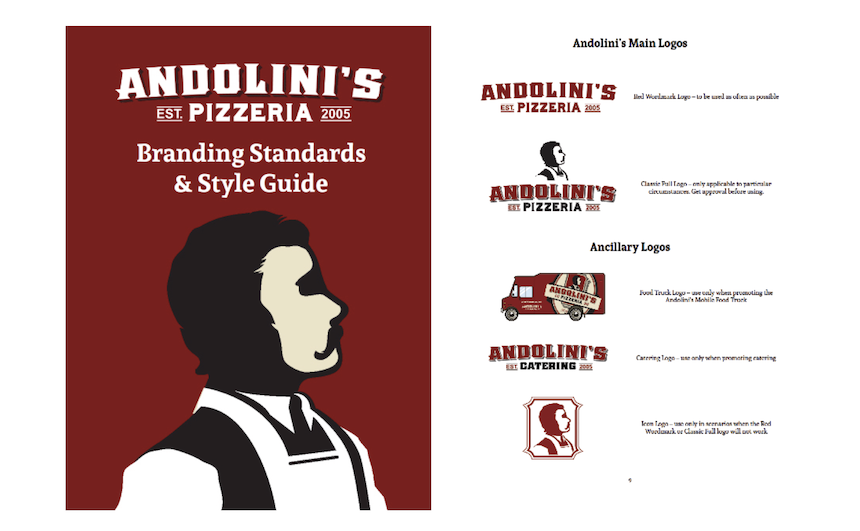Now, more than ever, you need to set the standard
When we first opened Andolini’s, developing our brand took time. We completely redid our logo six years after opening. We had to re-look at what our demo was and refocus our brand. Through all the changes, I’ve always ran point on all our marketing. I’ve been the one making the calls and creating the content. In the last 15 years, I’ve cultivated the message and voice of the Andolini’s brand.
I’ve received offers in the past for marketing projects where the salesperson would also draw up the art and message. When I would say yes to these projects, it would be a long, drawn-out process. It would involve me trying to explain our brand, getting them the right logos, and defining the voice and message I wanted to convey. It would become more work than it was worth, and I would end up redoing their work.
That was until I learned about making a Brand Standards package (BSP). I stumbled onto this a little over a year ago. It hit me square in the face as the most obvious thing that I should have been doing for a long time. I needed it asap.
A brand standards package encapsulates everything that your brand is. This way, you can give this package to an artist, designer, social media liaison or marketing firm and get it done. My BSP has my logos in vector art, along with details of what our color scheme is, down to the CMYK level. That’s fancy art talk for the numbers that your colors coordinate with by a specific number. I discovered another imperative, which is telling any designer what your brand IS NOT.
For Example:
- Use this logo for catering purposes
- Don’t use this logo in this context
- Always use these colors for the background
- Don’t use X color
- Use these fonts
- Speak factually about awards we’ve won
- Never speak braggy in the first person about Andolini’s
Decide based on things you’ve seen done with your brand that you did not care for to determine what you include here. State clearly what you don’t want to be done ever, and state it in a brand standards package.
My example of not being braggy is a real one. The free art I was offered from a colleague wanted to write, “You know Andolini’s is the best pizza in town, so come and get some.” This sounded like a nice compliment coming from them, but this ad was written in my voice. If it’s perceived that I wrote it, that would be a really lame way to market my restaurant. In my current BSP, it states ad copy should speak factually without opinion. To drive this point home, I video recorded myself on an iPhone stating all the things I want them to convey. I placed the video file in BSP folder. I say my points as if I’m right next to them, “Speak and write this way, and never this way. Place logos in a context that adds to the final product, etc.”
It’s now my expectation of anyone who wants my money via design work to abide by this package. Most designers thank me because it means less work trying to figure out and guess our brand intent. The specificity of a brand standards package helps our advertising appear seamless, regardless of the art designer.
This exercise also helped me hone in on what my brand is. You can do this yourself or have a marketing firm do it for anywhere from $1,000 to $3,000 as a fair cost. It’s money well spent if you have more than two stores and find yourself running around scatterbrained, trying to convey these points to multiple people. It can be a lot, trying to handle all the people speaking on behalf of your brand.
Even If you have just one store, it’s still a good idea to do this exercise yourself and create your BSP.









